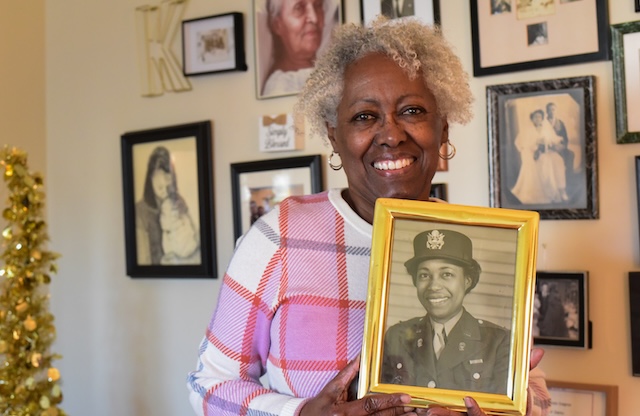Families salute Maryland women of the ‘Six Triple Eight’
By ROBERT STEWART
Catonsville, Md. – Nineteen women from Maryland served during World War II in the 6888th Battalion, the predominantly black postal unit now the subject of the blockbuster film “The Six Triple Eight.”
After decades of hearing their stories only as family lore, if they heard them at all, the families of these Marylanders are watching those stories come alive – and enjoying the long-awaited recognition for their service.
“I have wanted my mother and my aunt to be honored and to be appreciated for a long time,” said Karen Taylor, “and now because of the Tyler Perry movie the world knows what they accomplished.”
Although not the main characters in Perry’s movie, Taylor’s mother and aunt were both members of the postal unit featured in the film.
The Six Triple Eight, officially the 6888th Central Postal Directory Battalion, deployed to Europe for roughly a year during World War II. Some 855 women came from across the U.S. to process mail in the European theater of war.
They were a twice-segregated unit, as women served separately from men at the time, and women of color served separately from white women.
The film’s release before Christmas has reanimated discussion of the unit, bringing their accomplishments into public consciousness. For descendants and family members, it’s a culmination of a multi-year effort to bring awareness to their family’s military service.
Taylor, a 78-year-old retired dental hygienist, points to her living room wall lined with pictures of family members in her Catonsville apartment. Several items, including pictures, a U.S. flag, a certificate, and a movie poster indicate a connection to the 6888th.
“These women were fighting for us,” Taylor said, “Even if someone tells you you can’t do something, you don’t let it go at that. You keep on going and prove that you can.”
Taylor says that’s how her mother raised her.
Taylor’s mother, Vivian Elzie Taylor, was one of 19 women who enlisted in Maryland and deployed with the 6888th. After serving in Europe and meeting and marrying her husband, Elyseo J. Taylor, in Paris, she settled in Salisbury, Maryland.
She and her husband, a tanker in the first Black tank battalion, eventually divorced. Elzie Taylor went to teach art at the all-Black Salisbury High School in Maryland’s then-segregated school system.
From a segregated army to a segregated school system, Elzie Taylor’s mid-century career was emblematic of the challenges Black women faced in Maryland and around the country.
She passed a lesson on to her daughter about persevering in the face of obstacles.
“My mom pushed me,” Taylor said. “She made me.”
After her mom died, Taylor began exploring the military oral history her mother had shared with her. It wasn’t just her mother who served. Taylor’s aunt, Marian Elzie Wilson, enlisted in Pennsylvania and also deployed with the 6888th.
The more she learned, she said, the more she understood the groundbreaking territory the group charted.
And she wasn’t the only one.
Vashti Murphy Matthews, from Baltimore’s multi-generational publishing family of AFRO American Newspaper, also served overseas with the 6888th.
She was a taciturn woman who – despite a drill sergeant-like leadership style – never spoke about her time in the army, according to her daughter, Betty Schuler.
“Had it not been for me finding some pictures, we would never have known that she served at all,” said Schuler. “Not one word did she speak.”
Schuler and her cousin first learned about the 6888th when a monument was being erected in honor of the unit. Researchers and fundraisers were reaching out to descendants and media organizations, which led them to Schuler and her cousin, Frances Murphy Draper, CEO and publisher of the family business.
The Buffalo Soldier Educational and Historical Committee created a monument for the 6888th in Fort Leavenworth, Kansas, outside of Kansas City, in 2018.
A few years later, Congress passed legislation awarding the unit the Congressional Gold Medal. Maryland Gov. Wes Moore even designated March 9 as a day honoring the 6888th in Maryland.
But it wasn’t until the movie that the unit really caught people’s attention. Draper compares the Six Triple Eight to other overlooked stories about people of color.
“I think it also speaks to the ‘argument’ about the need to really teach African American history,” said Draper. “There’s a whole history of people, and the more we understand about people … the more we understand that we have more in common than we have different.”

Capital News Service is a student-powered news organization run by the University of Maryland Philip Merrill College of Journalism. With bureaus in Annapolis and Washington run by professional journalists with decades of experience, they deliver news in multiple formats via partner news organizations and a destination Website.

